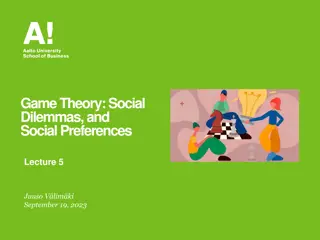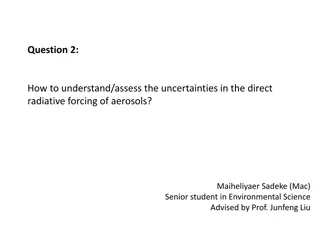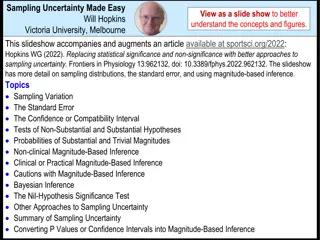Uncertainty and Precommitment in Social Dilemmas
This research explores the impact of uncertainty and precommitment on social dilemmas, specifically focusing on the Interdependent Security (IDS) scenario. It investigates how precommitment influences investment rates and decision-making in situations involving stochastic losses and risky investments. The study delves into real-life examples of precommitment strategies in long-term insurance, CO2 reductions, and safety decisions. By analyzing choice bracketing and subjective probabilities over time horizons, the research sheds light on how individuals navigate uncertainty and make strategic decisions in social dilemmas.
Download Presentation

Please find below an Image/Link to download the presentation.
The content on the website is provided AS IS for your information and personal use only. It may not be sold, licensed, or shared on other websites without obtaining consent from the author.If you encounter any issues during the download, it is possible that the publisher has removed the file from their server.
You are allowed to download the files provided on this website for personal or commercial use, subject to the condition that they are used lawfully. All files are the property of their respective owners.
The content on the website is provided AS IS for your information and personal use only. It may not be sold, licensed, or shared on other websites without obtaining consent from the author.
E N D
Presentation Transcript
"Once? No. Twenty times? Sure!" Uncertainty and precommitment in social dilemmas David J. Hardisty, Howard Kunreuther, David Krantz, Poonam Arora, Amir Sepehri UBC Sauder, UPenn, Columbia U, Manhattan College, Western Ivey Funding support from NSF and SSHRC Association for Consumer Research Dallas, TX Oct, 2018
Submitting Author: Amir Sepehri
IDS Background Interdependent Security (IDS) is a social dilemma with stochastic losses (Kunreuther & Heal, 2003) border security pest/disease control risky investments People cooperate less in IDS than in a typical Prisoner s Dilemma
Research Motivation In real life, people sometimes precommit to invest in protection for several years in advance at a time examples: long-term insurance contracts CO2 reductions safety decisions (seat-belt, helmet, etc)
Research Motivation Normally, greater delay is associated with increased uncertainty example: $10 promised today or in 20 years However, with repeated low probability events, increasing time horizon may increase subjective probability Examples (choice bracketing): Chance of a fire today or over 20 years? Wear your seatbelt just once or every time?
Study 1 Question 1: How does precommitment affect investment rates?
IDS instructions (pg 1) Scenario: Imagine you are an investor in Indonesia and you have a risky joint venture that earns 8,500 Rp per year. However, there is a small chance that you and/or your counterpart will suffer a loss of 40,000 Rp in a given year. You have the option to pay 1,400 Rp for a safety measure each year to protect against the possible loss. However, you will only be fully protected if both you and your counterpart invest in protection. The loss has an equal chance of happening each year, regardless of whether it occurred in the previous year.
IDS payoff matrix Your Counterpart NOT INVEST - You definitely lose 1,400 Rp and have a 1% chance of losing an additional 40,000 Rp. INVEST - You definitely lose 1,400 Rp, and have a 0% chance of the large loss occurring. You INVEST - Your counterpart definitely loses 1,400 Rp, and has a 0% chance of the large loss occurring. - You have a 3% chance of losing 40,000 Rp and a 97% chance of losing 0 Rp. - Your counterpart has a 3% chance of losing 40,000 Rp and a 97% chance of losing 0 Rp. NOT INVEST - You have a 4% chance of losing 40,000 Rp and a 96% chance of losing 0 Rp. - Your counterpart definitely loses 1,400 Rp and has a 1% chance of losing an additional 40,000 Rp. - Your counterpart has a 4% chance of losing 40,000 Rp and a 96% chance of losing 0 Rp.
PD payoff matrix Your Counterpart NOT INVEST - You lose 1,800 Rp. - Your counterpart loses 1,200 Rp. INVEST - You lose 1,400 Rp. - Your counterpart loses 1,400 Rp. You INVEST NOT INVEST - You lose 1,200 Rp. - Your counterpart loses 1,800 Rp. - You lose 1,600 Rp. - Your counterpart loses 1,600 Rp.
IDS: Choices Will you invest in protection this year? INVEST | NOT INVEST Do you think your counterpart will invest in protection this year? DEFINITELY | PROBABLY | PROBABLY NOT | DEFINITELY NOT
Precommitted Condition Will you invest in protection in year 1? INVEST | NOT INVEST Do you think your counterpart will invest in protection in year 1? DEFINITELY | PROBABLY | PROBABLY NOT | DEFINITELY NOT ~~~~~~~~~~~~~~~~~~~~~~~~~~~~~~~~~~~~~~~~~~~~~~~~~~~~~~~~~~~~~~~~~~~~~~ Will you invest in protection in year 2? INVEST | NOT INVEST Do you think your counterpart will invest in protection in year 2? DEFINITELY | PROBABLY | PROBABLY NOT | DEFINITELY NOT ~~~~~~~~~~~~~~~~~~~~~~~~~~~~~~~~~~~~~~~~~~~~~~~~~~~~~~~~~~~~~~~~~~~~~~ [...] Will you invest in protection in year 20? INVEST | NOT INVEST Do you think your counterpart will invest in protection in year 20? DEFINITELY | PROBABLY | PROBABLY NOT | DEFINITELY NOT
Feedback Year 1 Results Your choice: INVEST Your counterpart's choice: NOT INVEST The random number was: 88 This Means For you, the large loss: did not occur For your counterpart, the large loss: did not occur Result: You lost 1,400 Rp, and your counterpart lost 0 Rp
Design Details participants played blocks of 20 rounds ( years ) with an anonymous partner 4 blocks total random pairing before each block 1 block paid out for real money all manipulations between subject, 30 subjects per group
PD vs IDS 1 0.9 0.8 Investment Proportion 0.7 0.6 IDS rep 0.5 PD rep 0.4 0.3 0.2 0.1 0 Block 1 Block 2 Block 3 Block 4
PD vs IDS 1 0.9 0.8 Investment Proportion 0.7 0.6 IDS rep 0.5 PD rep 0.4 0.3 0.2 0.1 0 Block 1 Block 2 Block 3 Block 4
PD vs IDS 1 0.9 0.8 Investment Proportion 0.7 0.6 IDS rep 0.5 PD rep 0.4 0.3 0.2 0.1 0 Block 1 Block 2 Block 3 Block 4
Conclusion 1 Uncertainty lowers cooperation between individuals playing loss framed dilemma Why? - Perhaps uncertainty transforms the game from a social dilemma to a game of chance
IDS: repeated vs precommitted 1 0.9 0.8 Investment Proportion 0.7 0.6 IDS rep IDS pre PD rep 0.5 0.4 0.3 0.2 0.1 0 Block 1 Block 2 Block 3 Block 4
IDS: repeated vs precommitted 1 0.9 0.8 Investment Proportion 0.7 0.6 IDS rep IDS pre PD rep 0.5 0.4 0.3 0.2 0.1 0 Block 1 Block 2 Block 3 Block 4
Conclusion 2 Under uncertainty, precommitment raises cooperation Why? Perhaps precommitment raises subjective probability of the loss
Coded Free Responses 1.00 .90 Proportion of Participants Mentioning .80 .70 .60 Counterpart Probability .50 .40 .30 .20 .10 .00 SPD-rep E SPD-pre E DPD-rep E
Predictions of counterpart 1 0.9 Mean Investment Proportion 0.8 0.7 0.6 DPD-rep E SPD-pre E SPD-rep E 0.5 0.4 0.3 0.2 0.1 0 Definitely Not Probably Not Probably Definintely Prediction of Counterpart's Investment
Interesting results, but a major complicator: Partner interaction (or non-interaction) effects
Study 2 Question: Do individuals playing a (non-dilemma) solo game invest more often when precommitting?
Solo payoff matrix INVEST - You definitely lose 1,400 Rp, and have a 0% chance of the large loss occurring. NOT INVEST - You have a 4% chance of losing 40,000 Rp and a 96% chance of losing 0 Rp.
IDS repeated vs Solo repeated 1 0.9 0.8 Investment Proportion 0.7 0.6 IDS rep IDS pre Solo rep Solo pre 0.5 0.4 0.3 0.2 0.1 0 Block 1 Block 2 Block 3 Block 4
IDS repeated vs Solo repeated 1 0.9 0.8 Investment Proportion 0.7 0.6 IDS rep IDS pre Solo rep Solo pre 0.5 0.4 0.3 0.2 0.1 0 Block 1 Block 2 Block 3 Block 4
Conclusion 3 IDS players are mostly playing a game of chance, showing risk-seeking for losses
Solo: repeated vs precommited 1 0.9 0.8 Investment Proportion 0.7 0.6 IDS rep IDS pre Solo rep Solo pre 0.5 0.4 0.3 0.2 0.1 0 Block 1 Block 2 Block 3 Block 4
Solo: repeated vs precommited 1 0.9 0.8 Investment Proportion 0.7 0.6 IDS rep IDS pre Solo rep Solo pre 0.5 0.4 0.3 0.2 0.1 0 Block 1 Block 2 Block 3 Block 4
Conclusion 4 Precommitment raises investment rates by individuals Why? Perhaps subjective probability is increased
How else can we improve investment under uncertainty? Environmental framing? Highlight social goals and raise investment rates?
Study 3 Question: Will environmental framing will increase investment rates?
IDS environmental instructions Scenario: Imagine you are a farmer in Indonesia. You get an annual yield of 8,500 Rupiah (Rp) from your potato crops. Both you and a neighboring farmer use the pesticide Aldicarb on your potato crops. However, there is a small risk of groundwater contamination each year from this pesticide, which is toxic. If contamination occurs, you and/or your neighboring farmer will suffer a loss of 40,000 Rp, to pay for groundwater cleanup. You have the option to switch to a more expensive, though safer, pesticide, at the cost of 1,400 Rp annually, to avoid groundwater contamination. However, you will only be fully protected if both you and your counterpart invest in the safer pesticide. The groundwater contamination has an equal chance of happening each year, regardless of whether it occurred in the previous year.
IDS environmental payoff matrix Your Counterpart INVEST NOT INVEST You INVEST - You definitely lose 1,400 Rp, and have a 0% chance of groundwater contamination. - You definitely lose 1,400 Rp and have a 1% chance of groundwater contamination occuring and losing an additional 40,000 Rp. - Your counterpart definitely loses 1,400 Rp, and has a 0% chance of groundwater contamination. - Your counterpart has a 3% chance of losing 40,000 Rp due to groundwater contamination and a 97% chance of losing 0 Rp. - You have a 4% chance of groundwater contamination occurring and losing 40,000 Rp and a 96% chance of losing 0 Rp. NOT INVEST - You have a 3% chance of losing 40,000 Rp due to groundwater contamination and a 97% chance of losing 0 Rp. - Your counterpart definitely loses 1,400 Rp and has a 1% chance of groundwater contamination occuring and losing an additional 40,000 Rp. - Your counterpart has a 4% chance of groundwater contamination occurring and losing 40,000 Rp and a 96% chance of losing 0 Rp.
IDS Environmental: Choices Will you invest in the safer pesticide this year? INVEST | NOT INVEST Do you think your counterpart will invest in the safer pesticide this year? DEFINITELY | PROBABLY | PROBABLY NOT | DEFINITELY NOT
Feedback Year 1 Results Your choice: INVEST Your counterpart's choice: NOT INVEST The random number was: 88 This Means For you, groundwater contamination: did not occur For your counterpart, groundwater contamination : did not occur Result: You lost 1,400 Rp, and your counterpart lost 0 Rp
Environmental Frame Results 1 0.9 0.8 Investment Proportion 0.7 IDS rep IDS pre IDS rep E IDS pre E 0.6 0.5 0.4 0.3 0.2 0.1 0 Block 1 Block 2 Block 3 Block 4
Environmental Frame Results 1 0.9 0.8 Investment Proportion 0.7 IDS rep IDS pre IDS rep E IDS pre E 0.6 0.5 0.4 0.3 0.2 0.1 0 Block 1 Block 2 Block 3 Block 4
Environmental Frame Results 1 0.9 0.8 Investment Proportion 0.7 IDS rep IDS pre IDS rep E IDS pre E 0.6 0.5 0.4 0.3 0.2 0.1 0 Block 1 Block 2 Block 3 Block 4
Conclusion 5 Environmental framing may not have a significant effect on investment rates
Study 4 Question: How does precommitment affect investment rates in a deterministic prisoners dilemma
IDD payoff matrix Your Counterpart NOT INVEST - You lose 1,800 Rp. - Your counterpart loses 1,200 Rp. INVEST - You lose 1,400 Rp. - Your counterpart loses 1,400 Rp. You INVEST NOT INVEST - You lose 1,200 Rp. - Your counterpart loses 1,800 Rp. - You lose 1,600 Rp. - Your counterpart loses 1,600 Rp.
PD: Repeated vs Precommitted 1 0.9 0.8 Investment Proportion 0.7 0.6 PD rep PD pre 0.5 0.4 0.3 0.2 0.1 0 Block 1 Block 2 Block 3 Block 4
PD: Repeated vs Precommitted 1 0.9 0.8 Investment Proportion 0.7 0.6 PD rep PD pre 0.5 0.4 0.3 0.2 0.1 0 Block 1 Block 2 Block 3 Block 4
Conclusion 6 Precommitment reduces investment rates in deterministic social dilemmas Why? Perhaps individuals realize there is no opportunity for reciprocity and are worried about being a sucker
Summary: a pretty 2x2 0.85 0.75 Mean Investment 0.65 Proportion 0.55 0.45 0.35 0.25 DPD SPD Precommitment Repeated
Study 5 Solo game, N=355 Repeated vs Precommitted Loss vs Gain
Study 5: Results 0.8 Mean investment proportion 0.7 0.6 0.5 0.4 0.3 0.2 0.1 0 Loss Gain Repeated Precomitted
Summary Precommitment lowers cooperation in regular prisoner s dilemma, but raises it in interdependent security situations Why? In IDS, precommitment raises subjective probability of loss, but in the deterministic case it removes the possibility of reciprocity



























